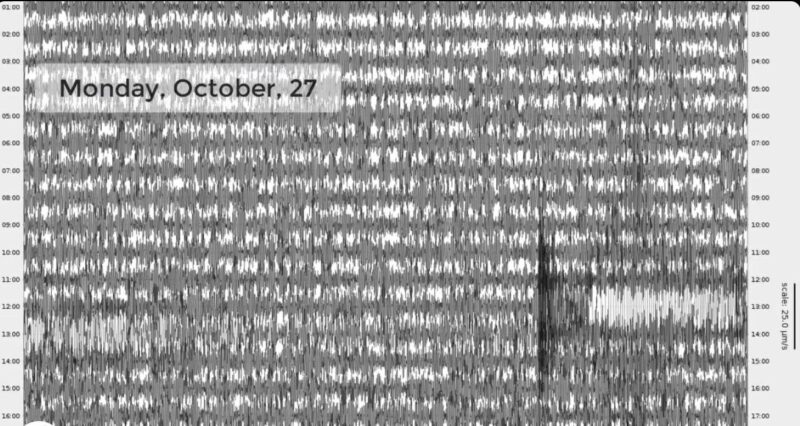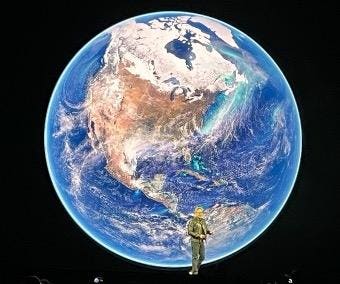Seismic activity detected on Otober 27, 2025 as Hurricane Melissa approached Jamaica.
Station Monitor/SAGE/Earthscope Consortium (CC BY 4.0)
Hurricane Melissa was a life-changing storm for Jamaica and other parts of the Caribbean. The Category 5 storm will likely be one of the strongest storms on record. Unfortunately, the intensity of the storm is breeding wild conspiracy theories and claims. Earlier this week, I debunked claims linking the hurricane to HAARP. While shopping for last-minute Thanksgiving desserts yesterday, a Caribbean woman said that she saw a viral video claiming that Hurricane Melissa cracked the seafloor and is supposed to cause a massive earthquake in the region. In that moment, I was able to put on my professorial hat and clarify the science.
Bathymetric data of the central Caribbean region.
NOAA
The Claim
Several Jamaican friends confirmed to me that this claim was making the rounds within their circle of friends, family and social media outlets. I decided to dig up the video. In the video, a claim is made that a massive earthquake is coming to Puerto Rico, Jamaica, and other parts of the central Caribbean. The apparent premise is that Hurricane Melissa caused a large crack within the seafloor of something referred to as the Puerto Rico Channel. I struggled to find any geographic reference to the channel, but there are certainly several areas in the map above that may represent the alleged location.
The video information also claims the earthquake will happen within 45 to 60 days and that Mt. Everest can fit within the crack. I find no reports from any official geological institution that there is a crack in any channel caused by Melissa.
IN SPACE, CARIBBEAN SEA – OCTOBER 26: (EDITOR’S NOTE: This Handout image was provided by a third-party organization and may not adhere to Getty Images’ editorial policy.) In this handout satellite image provided by the National Oceanic and Atmospheric Administration (NOAA) , Hurricane Melissa strengthens into a Category 4 storm as it churns northwest through the Caribbean Sea captured at 7:40Z on October 26, 2025. Hurricane Melissa has intensified into a Category 4 hurricane and could further develop into a Category 5 as it approaches Jamaica, according to the National Hurricane Center. (Photo by NOAA via Getty Images)
Getty Images
Can Hurricanes Affect Seismic Activity?
While that current claim is grossly exaggerated, there are ways that hurricanes impact seismic activity. My hunch is the video is a conflation of the real science information and local awe at the sheer magnitude or destruction associated with Hurricane Melissa. As I wrote leading up to landfall, Melissa would be a storm like nothing experienced by any living in Jamaica. When a “shock” of this magnitude strikes, people often find ways to cope or explain the experience.
Let’s discuss scientifically-known ways Hurricane Melissa did impact seismic activity. In a really helpful video posted as Hurricane Melissa approached Jamaica, Dr. Wendy Bohon posted a discussion explaining that readings from a seismic station in Jamaica was detecting the hurricane as it approached the island. Bohon, who is Branch Chief of Seismic Hazards and Earthquake Engineering at the California Geological Survey, wrote, “Hurricanes increase the amplitude of ocean waves which beat on the coast and sea floor. These produce energy waves that can be seen as increasingly thick “wiggles” in the seismic recordings from stations near the approaching storm.” Pressure fluctuations likely contribute to the readings as well.
It’s not just the wave action. Wind from the hurricane shakes buildings, trees, power poels and other infrastructure. That can all be detected by seismometers. Bohon told Robin George Andrews in Scientific American, “Seismometers aren’t just used for earthquakes. She went on to say, ”Seismometers detect anything that puts energy into the ground. That could be Taylor Swift concerts; that could be construction; that could be people walking around seismometers.”
TOPSHOT – Electrical poles are down as a man bikes through the destroyed neighborood of North Street following the passage of Hurricane Melissa, in Black River, Jamaica on October 29, 2025. Hurricane Melissa bore down on the Bahamas October 29 after cutting a path of destruction through the Caribbean, leaving 30 people dead or missing in Haiti and parts of Jamaica and Cuba in ruins. Somewhat weakened but still threatening, Melissa will bring damaging winds and flooding rains to the Bahamas Wednesday before moving on to Bermuda late Thursday, according to the US National Hurricane Center (NHC). (Photo by Ricardo MAKYN / AFP) (Photo by RICARDO MAKYN/AFP via Getty Images)
AFP via Getty Images
There are some studies linking extreme precipitation with earthquake activity. An MIT-led study published in Nature found that heavy snowfall and rain could affect “pore fluid pressure.” This is pressure caused by fluids in the various cracks within the Earth’s bedrock. Such pore pressure fluctuations can affect the speed of seismic waves. Researchers in France have also explored connections between increase fluid pressure from extreme rainfall and earthquake activity.
According to the U.S. Geological Survey website, “In the 4th Century B.C., Aristotle proposed that earthquakes were caused by winds trapped in subterranean caves. Small tremors were thought to have been caused by air pushing on the cavern roofs, and large ones by the air breaking the surface.” Over time, this led to claims of earthquake weather. The website went on to say, “There is no such thing as “earthquake weather.” Statistically, there is approximately an equal distribution of earthquakes in cold weather, hot weather, rainy weather, etc.” However, the website acknowledged isolated cases in which, “Very large low-pressure changes associated with major storm systems (typhoons, hurricanes, etc)” triggered fault slip (slow earthquakes).
In summary, there are certainly connections between hurricanes and earthquake activity, but there is no scientific evidence of a crack in the seafloor being caused by Hurricane Melissa. Could an earthquake happen in Jamaica or Puerto Rico at some point today, next month, or next year? Absolutely, it can. In fact, weak seismic activity is fairly common in this region. According to the SAGE website operated by Earthscope, “Jamaica straddles the Caribbean Plate and the Gonâve Microplate, the largest of four microplates that are caught in a crunch between the North American and Caribbean Plates. Jamaica has had a long history of deadly earthquakes; the biggest in 1692 and 1907.”
My heart aches for the people of Jamaica and other affected regions. With everything they are dealing with, I didn’t want a viral exaggeration to cause even more concerns.
Faults and locations of major earthquakes in Jamaica.
NSF, SAGE, and Earthscope









